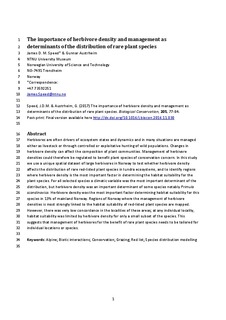| dc.contributor.author | Speed, James David Mervyn | |
| dc.contributor.author | Austrheim, Gunnar | |
| dc.date.accessioned | 2017-06-01T07:17:03Z | |
| dc.date.available | 2017-06-01T07:17:03Z | |
| dc.date.created | 2016-12-08T10:30:57Z | |
| dc.date.issued | 2016 | |
| dc.identifier.citation | Biological Conservation. 2016, 205 77-84. | nb_NO |
| dc.identifier.issn | 0006-3207 | |
| dc.identifier.uri | http://hdl.handle.net/11250/2444037 | |
| dc.description.abstract | Herbivores are often drivers of ecosystem states and dynamics and in many situations are managed either as livestock or through controlled or exploitative hunting of wild populations. Changes in herbivore density can affect the composition of plant communities. Management of herbivore densities could therefore be regulated to benefit plant species of conservation concern. In this study we use a unique spatial dataset of large herbivores in Norway to test whether herbivore density affects the distribution of rare red-listed plant species in tundra ecosystems, and to identify regions where herbivore density is the most important factor in determining the habitat suitability for the plant species. For all selected species a climatic variable was the most important determinant of the distribution, but herbivore density was an important determinant of some species notably Primula scandinavica. Herbivore density was the most important factor determining habitat suitability for this species in 13% of mainland Norway. Regions of Norway where the management of herbivore densities is most strongly linked to the habitat suitability of red-listed plant species are mapped. However, there was very low concordance in the localities of these areas; at any individual locality, habitat suitability was limited by herbivore density for only a small subset of the species. This suggests that management of herbivores for the benefit of rare plant species needs to be tailored for individual locations or species. | nb_NO |
| dc.language.iso | eng | nb_NO |
| dc.publisher | Elsevier | nb_NO |
| dc.rights | Attribution-NonCommercial-NoDerivatives 4.0 Internasjonal | * |
| dc.rights.uri | http://creativecommons.org/licenses/by-nc-nd/4.0/deed.no | * |
| dc.title | The importance of herbivore density and management as determinants of the distribution of rare plant species | nb_NO |
| dc.type | Journal article | nb_NO |
| dc.type | Peer reviewed | nb_NO |
| dc.source.pagenumber | 77-84 | nb_NO |
| dc.source.volume | 205 | nb_NO |
| dc.source.journal | Biological Conservation | nb_NO |
| dc.identifier.doi | 10.1016/j.biocon.2016.11.030 | |
| dc.identifier.cristin | 1409997 | |
| dc.description.localcode | © 2016 Elsevier Ltd. All rights reserved. This is the authors' accepted and refereed manuscript to the article. Locked until 31 January 2019 due to copyright restrictions | nb_NO |
| cristin.unitcode | 194,31,10,0 | |
| cristin.unitname | Seksjon for naturhistorie | |
| cristin.ispublished | true | |
| cristin.fulltext | postprint | |
| cristin.qualitycode | 1 | |

